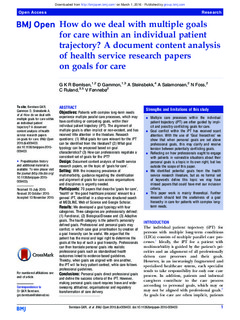| dc.contributor.author | Berntsen, Gro Karine Rosvold | |
| dc.contributor.author | Gammon, Barbara Deede | |
| dc.contributor.author | Steinsbekk, Aslak | |
| dc.contributor.author | Salamonsen, Anita | |
| dc.contributor.author | Foss, Nina | |
| dc.contributor.author | Ruland, Cornelia | |
| dc.contributor.author | Fønnebø, Vinjar | |
| dc.date.accessioned | 2016-03-01T10:17:35Z | |
| dc.date.accessioned | 2016-03-04T14:10:28Z | |
| dc.date.available | 2016-03-01T10:17:35Z | |
| dc.date.available | 2016-03-04T14:10:28Z | |
| dc.date.issued | 2015 | |
| dc.identifier.citation | BMJ Open 2015, 5(12):1-8 | nb_NO |
| dc.identifier.issn | 2044-6055 | |
| dc.identifier.uri | http://hdl.handle.net/11250/2381464 | |
| dc.description.abstract | Objectives Patients with complex long-term needs experience multiple parallel care processes, which may have conflicting or competing goals, within their individual patient trajectory (iPT). The alignment of multiple goals is often implicit or non-existent, and has received little attention in the literature. Research questions: (1) What goals for care relevant for the iPT can be identified from the literature? (2) What goal typology can be proposed based on goal characteristics? (3) How can professionals negotiate a consistent set of goals for the iPT?
Design Document content analysis of health service research papers, on the topic of ‘goals for care’.
Setting With the increasing prevalence of multimorbidity, guidance regarding the identification and alignment of goals for care across organisations and disciplines is urgently needed.
Participants 70 papers that describe ‘goals for care’, ‘health’ or ‘the good healthcare process’ relevant to a general iPT, identified in a step-wise structured search of MEDLINE, Web of Science and Google Scholar.
Results We developed a goal typology with four categories. Three categories are professionally defined: (1) Functional, (2) Biological/Disease and (3) Adaptive goals. The fourth category is the patient's personally defined goals. Professional and personal goals may conflict, in which case goal prioritisation by creation of a goal hierarchy can be useful. We argue that the patient has the moral and legal right to determine the goals at the top of such a goal hierarchy. Professionals can then translate personal goals into realistic professional goals such as standardised health outcomes linked to evidence-based guidelines. Thereby, when goals are aligned with one another, the iPT will be truly patient centred, while care follows professional guidelines.
Conclusions Personal goals direct professional goals and define the success criteria of the iPT. However, making personal goals count requires brave and wide-sweeping attitudinal, organisational and regulatory transformation of care delivery. | nb_NO |
| dc.language.iso | eng | nb_NO |
| dc.publisher | BMJ Publishing Group | nb_NO |
| dc.relation.uri | http://bmjopen.bmj.com/content/5/12/e009403.full.pdf+html | |
| dc.title | How do we deal with multiple goals for care within an individual patient trajectory? A document content analysis of health service research papers on goals for care | nb_NO |
| dc.type | Peer reviewed | nb_NO |
| dc.type | Journal article | en_GB |
| dc.date.updated | 2016-03-01T10:17:35Z | |
| dc.source.volume | 5 | nb_NO |
| dc.source.journal | BMJ Open | nb_NO |
| dc.source.issue | 12 | nb_NO |
| dc.identifier.doi | 10.1136/bmjopen-2015-009403 | |
| dc.identifier.cristin | 1312173 | |
| dc.description.localcode | This is an Open Access article distributed in accordance with the Creative Commons Attribution Non Commercial (CC BY-NC 4.0) license, which permits others to distribute, remix, adapt, build upon this work non-commercially, and license their derivative works on different terms, provided the original work is properly cited and the use is non-commercial. See: http://creativecommons.org/licenses/by-nc/4.0/ | nb_NO |
